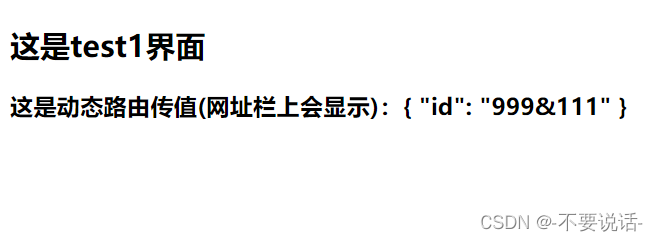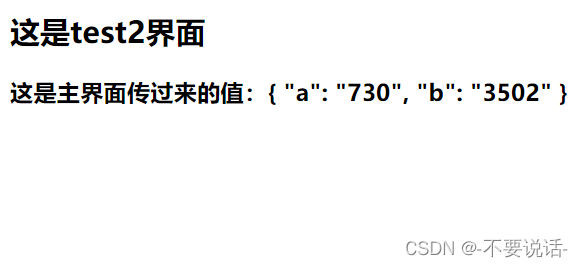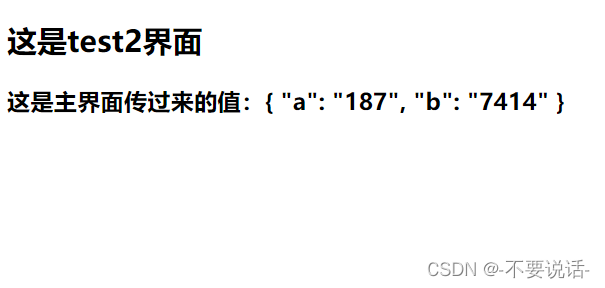query传参
2种传参:
1、<router-link to="/xx?name=karen&pwd=123">go</router-link>
2、this.$router.push({path:"/xx",query:{name:"karen",pwd:123}})
//在路由匹配的组件中获取数据:
mounted(){let queryObj=this.$route.query}
动态路由传参
设计:
const router=new VueRouter({
routes:[
{path:"/home/:id",component:()=>import("./home.vue")},
{path:"/about",component:()=>import("./about.vue")}]
})
2种传参:
<router-link to="/home/123">go</router-link>
this.$router.push({path:"/home",params:{id:123}})
// 如果提供了 path,params 会被忽略,上述例子中的 query 并不属于这种情况。取而代之的是下面例子的做法,你需要提供路由的 name 或手写完整的带有参数的 path:
//在路由匹配的组件中获取数据:
mounted(){let paramsObj=this.$route.params}
案例
路由代码:
import Vue from 'vue' import VueRouter from 'vue-router' import HomeView from '../views/HomeView.vue' Vue.use(VueRouter) const routes = [ { path: '/', name: 'home', component: HomeView }, { path: '/test1/:id', //动态路由 name: 'test1', component: () => import('../views/test1View.vue') }, { path:'/test2', name:'test2', component:()=>import('../views/test2View.vue') } ] const router = new VueRouter({ routes }) export default router主界面代码:
<template> <div> <h1>这是主页面</h1> <div class="test1"> <h2>动态路由传参</h2> <router-link to="/test1/999&111">1、跳转test1界面</router-link> <br /> <router-link :to="{path:'/test1/666'}">2、跳转test1界面</router-link> <br /> <button @click="link1(555)">3、跳转test1界面</button> </div> <div class="test2"> <h2>传参</h2> <router-link to="/test2?id=123456&pwd=abc123">1、跳转test2界面</router-link> <br /> <router-link :to="{path:'/test2',query:{a:1000,b:200}}">2、跳转test2界面</router-link> <br /> <button @click="link2(730,3502)">3、跳转test2界面</button> <button @click="link3(187,7414)">3、跳转test2界面</button> </div> </div> </template> <script> export default { name: 'HomeView', methods: { link1(arg) { this.$router.push(`/test1/${arg}`) }, link2(arg1,arg2) { this.$router.push(`/test2?a=${arg1}&b=${arg2}`) }, link3(arg1,arg2) { this.$router.push({path:'/test2',query:{a:arg1,b:arg2}}) } } } </script> <style lang="css" scoped> .test1 { background-color: antiquewhite; } .test2 { background-color: rgb(167, 230, 164); } </style>test1界面代码
<template> <div> <h2>这是test1界面</h2> <h3>这是动态路由传值(网址栏上会显示):{ {msg}}</h3> </div> </template> <script> export default { name: 'VueTest1View', data() { return { msg:"" }; }, mounted() { console.log(this.$route.params.id) //params去接收 this.msg=this.$route.params }, methods: { }, }; </script> <style lang="sass" scoped> </style>test2界面代码
<template> <div> <h2>这是test2界面</h2> <h3>这是主界面传过来的值:{ {msg}}</h3> </div> </template> <script> export default { name: 'VueTst2View', data() { return { msg:"" }; }, mounted() { console.log(this.$route) this.msg=this.$route.query //将传入的值保存起来 }, methods: { }, }; </script> <style lang="sass" scoped> </style>
效果图:
分别点击动态路由传参的各个链接得到的结果为
1、
2、
3、
分别点击query传参传参的各个链接得到的结果为
1、
2、
3、
4、







